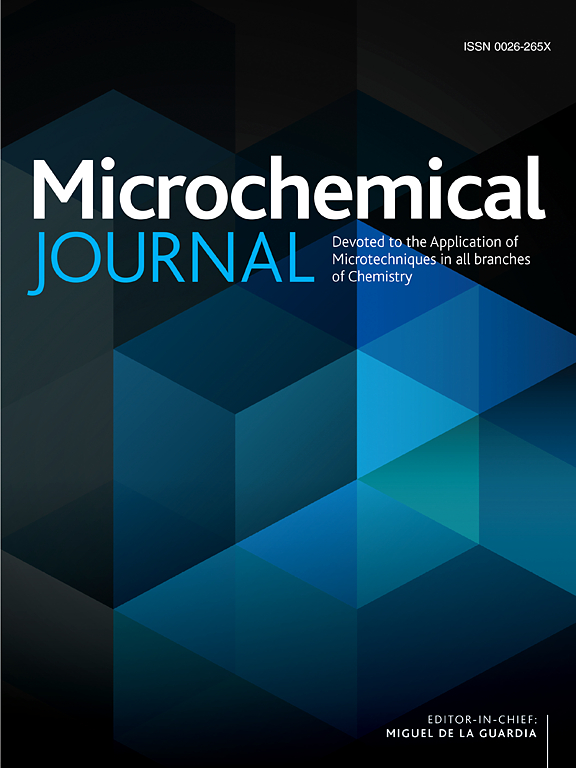创新的生物质衍生P, N-CQDs用于人血浆和剂型中新型抗病毒药物巴洛韦马博西的灵敏测定
IF 4.9
2区 化学
Q1 CHEMISTRY, ANALYTICAL
引用次数: 0
摘要
本工作提出了一种新颖、快速、经济的植物基磷和氮掺杂碳量子点(P, N-CQDs)的一锅合成方法。以尿素和磷酸一铵(NH4H2PO4)为氮源和磷源,微波处理三色菜叶片80 s后,可形成蓝色发光P, N-CQDs (λex/λem为320/405 nm)。合成的CQDs具有高量子产率(35.23%)和高磷、高氮含量等特点。此外,它们作为一种荧光纳米探针,对一种新的抗流感药物baloxavir marboxil (BXM)的敏感测定表现出了显著的效率,该药物最近被报道广泛用于治疗COVID-19。BXM在0.2 ~ 18.0 μg/mL的浓度范围内,通过内部过滤效应和静态猝灭的协同作用,定量猝灭P, N-CQDs的天然荧光,LOD为0.04 μg/mL。验证了探针在不同金属离子、共给药和可能共存的赋形剂存在下的选择性。该方法可用于中药片剂和人血浆中BXM的测定,回收率分别为100.44±1.02%和100.23±1.06%。最后,采用不同的指标对建议探针的绿色度进行了评估,证实了其良好的绿色度。利用廉价、低能的微波辐射快速合成P, N-CQDs,并且不需要有机溶剂,使所生产的探针对环境友好。本研究拓展了P, N-CQDs在生物医学和药物分析中的应用。本文章由计算机程序翻译,如有差异,请以英文原文为准。

Innovative biomass-derived P, N-CQDs for the sensitive determination of the novel antiviral baloxavir marboxil in human plasma and dosage forms
This work presents a novel, quick, and economical one-pot synthesis of plant-based phosphorus and nitrogen-doped carbon quantum dots (P, N-CQDs). Microwave treatment of Tricolor Crassula (Crassula ovata) leaves as carbon sources with urea and monobasic ammonium phosphate (NH4H2PO4) as nitrogen and phosphorus sources for 80 s resulted in the formation of blue emissive P, N-CQDs (λex/λem of 320/405 nm). The synthesized CQDs were fully characterized, revealing a great quantum yield (35.23 %) and high phosphorus and nitrogen content. Furthermore, they exhibited remarkable efficiency as a fluorescent nanoprobe for the sensitive determination of a new anti-influenza drug, baloxavir marboxil (BXM), which was recently reported to have wide utility as a medication for COVID-19. BXM quantitatively quenched the native fluorescence of P, N-CQDs through a synergistic combination of inner filter effect and static quenching over the concentration range of 0.2–18.0 μg/mL with a LOD of 0.04 μg/mL. The selectivity of the probe was verified in the presence of different metal ions, co-administered drugs, and potential co-existing excipients. The proposed method was further applied for BXM determination in pharmaceutical tablets and spiked human plasma with good percentage recoveries (100.44 ± 1.02 % and 100.23 ± 1.06 %). Finally, the suggested probe’s greenness was assessed using different metrics, confirming its excellent greenness. The rapid synthesis of P, N-CQDs utilizing inexpensive, low-energy microwave radiation and the lack of organic solvents make the produced probe environmentally friendly. This study expands the applications of P, N-CQDs in biomedical and pharmaceutical analysis.
求助全文
通过发布文献求助,成功后即可免费获取论文全文。
去求助
来源期刊

Microchemical Journal
化学-分析化学
CiteScore
8.70
自引率
8.30%
发文量
1131
审稿时长
1.9 months
期刊介绍:
The Microchemical Journal is a peer reviewed journal devoted to all aspects and phases of analytical chemistry and chemical analysis. The Microchemical Journal publishes articles which are at the forefront of modern analytical chemistry and cover innovations in the techniques to the finest possible limits. This includes fundamental aspects, instrumentation, new developments, innovative and novel methods and applications including environmental and clinical field.
Traditional classical analytical methods such as spectrophotometry and titrimetry as well as established instrumentation methods such as flame and graphite furnace atomic absorption spectrometry, gas chromatography, and modified glassy or carbon electrode electrochemical methods will be considered, provided they show significant improvements and novelty compared to the established methods.
 求助内容:
求助内容: 应助结果提醒方式:
应助结果提醒方式:


